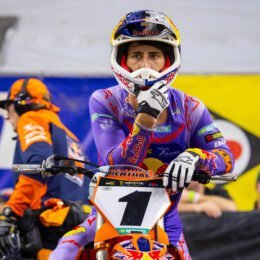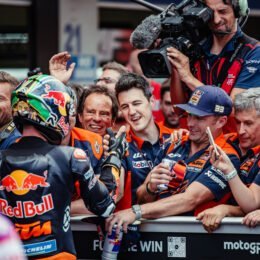Under the skin of KTM and Moto3
Want to know where the Moto3 ‘Orange missiles’ are built? We look into the factory’s racing department and have a chat with engineer and Road Racing Senior Manager Wolfgang Felber…
Munderfing is a little Austrian village next to Mattighofen. Here, in an industrial area, next to the KTM engine factory and the vast WP Performance systems plant, you find the headquarters of KTM Factory Racing. The single storey building is separated into a large office and four working sections for road racing, motocross, enduro and rally-raid. Working staff numbers around 80 people.
Up to last year the structure was different. The off-road departments were located somewhere inside the mighty R&D dept situated just alongside the KTM factory main building in Mattighofen, and the road guys were in one corner of the main edifice, close to the office of sporting director Pit Beirer. Now all the sporting departments have moved in together.
Nobody just walks into KTM Factory Racing. Behind the entrance is a reception operated by two people. All doors departing from here are locked and can be passed only with special electronic security device. Luckily a friendly person from KTM accompanies me through to the road racing zone, which basically devotes itself to Moto3 activities.
A quick look around first…To the right is the workshop. Orange tool containers form a circle and blue lifting platforms carry three disassembled race bikes. Fairings and all kinds of parts are placed around the workplace. The impression is clean, well illuminated, efficient and organised. Mechanics are focused on the bikes but offer a friendly nod.
Some Moto3 machines from last season are parked outside of the working area; one in a Red Bull outfit from world champion Sandro Cortese, another is an unpainted production racer and then a mysterious white bike. Shelves are lined with forks and shock dampers. On a table several engines parts are laid out, some crankshafts visible.
Several rooms form the left part of the workshop. One contains two huge special tooling machines (4 and 5 axles) to produce all kinds of parts, plus a CNC lathe. Later we are informed that these productions tools are used for race bikes only and that they are constantly in use. Also there are separate rooms for an engine test-bench and for welding of prototype frames. In an office close by somebody is sitting in front of a computer. On the screen the fabricating design of a fork yoke is turned around and worked on. A familiar face is sitting alongside working on his laptop: German Konrad Hefele, ex-team chief of the 125 Junior Team as well as the successful IDM Superbike team, now he is incorporated into the Moto3 project.
Two registered RC8 R superbikes and two Duke 125s are parked in front of the office room. This is the test fleet, as is explained, for the people working here. If they want to take a ride, they are free to grab a bike. Near here is the electronic department. A technician cares for harness wiring, cockpits, sensors and other curious or fancy stuff.
Wolfgang Felber, Road Racing Senior Manager, picks me up. We sit down in a meeting room and I can ask some questions.
Can you explain a little bit about how the Moto3 set-up operates?
Well, racing and development are separated and KTM Factory Racing is the head of the operation. We develop and build the bikes and the team from Aki Ayo, which is based near Barcelona in Spain, takes care of the racing operation. They also take care of all service and maintenance during the season. KTM furnishes them with all parts and material. The Ajo mechanics come here to build the bikes from the frame up after all parts have been fabricated during the off-season. Development during the season is accomplished by KTM of course and all the engineering, construction and fabrication happens here at KTM factory racing. For certain tasks the R&D department in Mattighofen assists us. For example, with calculation work, for the engine configuration, exhaust etc, also for calculation of frame stability and swingarm construction.
Winning the Moto3 World Championship with Sandro Cortese…it must have been something immensely satisfying…
For sure, that was great. Unfortunately we couldn´t enjoy it that much. For almost two years now we have been working flat out on the project. The day Sandro won the title we were at the airport at 7 o´clock in the morning to fly to Spain for a test with the new 2013 bike! This racing romantic ideal that you win and have a big party right away does not exist any more. Everything has to move on seamlessly. But the feeling of success was overwhelming of course. KTM began the Moto3 project with some delay. When we started Honda had already finished their bike! Then the technical rules were changed; the rev limit was lowered from 15.000 to 14.000 rpm. So the job was not easy for us at all.
I can remember well the middle and end of the 2011 racing season, when we did the IDM Superbike championship with our RC8 R. The people working on the Moto3 project were exactly the same as those on the IDM. On the one hand we had to secure the superbike title with Martin Bauer, on the other hand we had to devote ourselves to Moto3. That was somewhat problematic, also to switch from a ‘little flame’ development to full thrust after the final IDM race and after winning the title!
Was there a great deal of optimism entering the new season?
To be honest we did not know where we stood. The 125 two stroke of the Bartol era had an aluminium-frame. For Moto3 we decided to build a steel frame, WP performance came in with a new suspension idea. Our concept was different from others and what we had done in the past. So it was a relief to see at the IRTA test that the package was OK. The bike was fast and all the riders reported having a good feeling with it; that was very important and positive because the normal situation is that some riders get along with a new bike and others don’t and this wasn’t the case.
The first GP in Qatar was a bit ‘off’ for us but we were able to do our conclusions and develop the bike further. During the season we progressed and got stronger little by little. The chassis underwent several steps in terms of evolution. We changed the chassis flex to make progress with set-up and to get a better feeling for the riders with the tyres. The engine stayed virtually the same, as the rules practically demand that we supply all the riders with the same engine technology.
Many people came to realise that the KTM engine was stronger than the Honda…
We have not analysed the Honda engine. One difference is that ours is short-stroked and uses the 81mm bore allowed by the rules. Maybe our approach is more radical. The engine design is made by Kurt Trieb, who also designed our MotoGP V4 unit, and there are some similarities. Radial valves and conic cams, along with rocker arms, which proved to be a good solution.
Our MotoGP engine was technically very promising; the layout was super modern at the time. Unfortunately the project fared under difficult conditions, funding was insufficient. The constellation with the Roberts team did not fit well and came to an end pretty fast. But I always say, you never strive for something and it turns out in vain. We gained quite a few solutions and know-how for the Moto3 project as we squeezed it down to 250cc. So the experience with the MotoGP engine turned out to have a lot of value.
KTM won the last eight races and also the title. Have you been able to set new goals for the 2013 bike?
We think so. Next year’s bike is an evolution. Lots of stuff looks the same but in reality quite a lot has changed. We have managed to simplify things and use fewer parts. The bike will be lighter and we have made forward progress with performance.
Who is best placed to step into Sandro Cortese’s shoes?
Maybe Luis Salom and Maverick Vinales, who rides for KTM now in the LaGlisse team. Zulfahmi Khairuddin can also do very well, it depends on how much he progresses over the season…but you never know. Usually some other riders can come up during the year. The learning curve of young riders can be very steep.
And the Moto3 production racer RC250R?
The production racer costs 45,000 euros and 40 units will be built. Assembly takes place in Mattighofen on a small production line we usually use for the training assembly of new models. The motorcycles for the Red Bull MotoGP Rookies Cup will be put together in Spain in Manresa near Barcelona, where the headquarters for the cup are. We send down all the parts and the Cup mechanics construct the bikes. This is perfect practice for them and also they are keen to do this. Production racers and cup bikes only differ in paint and the exhaust; the rest is identical.











